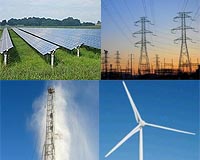 |
Kiel, Germany (SPX) Jul 07, 2010 Crude oil, coal and natural gas are not the only fossil fuels hidden deep below the surface of the Earth. Right around the globe, enormous quantities of methane hydrates can be found as many people already know, especially since Frank Schatzings famous novel 'The Swarm' (Der Schwarm). This white combustible ice consists of water and methane gas. If thawed in a controlled fashion, many billions of tons of methane could be obtained from it. The question is: do methane hydrate have a genuine role to play in our energy future? Based on current estimates, known reserves comprise roughly 12,000 billion tons of methane hydrates. Substantial deposits are located on continental shelves in the Pacific around Japan, off the Pacific coastline of America and to the North of Canada and Siberia. These deposits are located deep down in the seabed and locked into land-based permafrost for a very good reason: methane hydrates cannot form solid ice crystals until the pressure exceeds 20 bar and temperature fall below four degrees Celsius. The ice evaporates at lower pressure or higher temperature, and in the process, releases 164 times its own volume in the form of gas.
Swapping carbon dioxide for methane As methane burns, this carbon is converted into the greenhouse gas carbon dioxide. On the other hand, it can be used efficiently in modern gas-fired power stations to generate electricity. At this time, researchers are working on the possibility of separating carbon dioxide from the combustion gases of future power stations, and pumping it separately into subterranean storage facilities. The approach adopted by German researchers at the IFM-Geomar Institute (Leibniz Institute of Marine Sciences) at the University of Kiel is very interesting. As part of the SUGAR project (Submarine Gas hydrate Reservoirs), they wish to run tests to establish if the methane extracted from methane hydrates can be replaced by pumping in carbon dioxide. The principle being that water, through a chemical reaction with carbon dioxide, should form a stable and solid compound of carbon dioxide hydrates. If methane hydrates were ever extracted from continental shelves without appropriate precautionary measures being taken, the disaster scenario painted by Schatzing in 'The Swarm' could occur: without methane hydrates, the shelves on the coasts could become unstable, gigantic landmasses could start to slip and that in turn could trigger tsunamis. Experts are taking these risks seriously and are only experimenting on the extraction of methane hydrates in flat storage locations far from continental shelves.
Extraction unlikely to prove economically viable Similar pilot projects on storage deposits on the seabed off the coastline of Japan may be initiated a few years later. At present, it is not possible to predict when or even if at all it will be possible to exploit methane hydrate reserves in an economically feasible manner, with acceptable levels of risk to climate and geological stability.
Share This Article With Planet Earth
Related Links SUGAR Project at IFM-GEOMAR
 Renewable Capacity Soars Across EU
Renewable Capacity Soars Across EUBrussels, Belgium (SPX) Jul 07, 2010 In 2009, and in absolute terms, about 19.9% (608 TWh) of Europe's total electricity consumption (3042 TWh) came from renewable energy sources. Hydro power contributed with the largest share (11.6%), followed by wind (4.2%), biomass (3.5%), and solar (0.4%). With regards to the new capacity constructed that same year (27.5 GW), among the renewable sources, 37.1% was wind power, 21% photovol ... read more |
|
| The content herein, unless otherwise known to be public domain, are Copyright 1995-2010 - SpaceDaily. AFP and UPI Wire Stories are copyright Agence France-Presse and United Press International. ESA Portal Reports are copyright European Space Agency. All NASA sourced material is public domain. Additional copyrights may apply in whole or part to other bona fide parties. Advertising does not imply endorsement,agreement or approval of any opinions, statements or information provided by SpaceDaily on any Web page published or hosted by SpaceDaily. Privacy Statement |